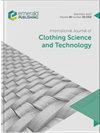罗丹明B染料自染丝绸纱线的性能研究
IF 1
4区 工程技术
Q3 MATERIALS SCIENCE, TEXTILES
International Journal of Clothing Science and Technology
Pub Date : 2023-04-21
DOI:10.1108/ijcst-10-2022-0147
引用次数: 1
摘要
目的纺织工业在染色过程中消耗了大量的水,排放了大量的废水。本研究旨在用罗丹明B(RhB)表征自染丝绸的时尚应用,以减少纺织品对环境的危害,提高丝绸的附加值。设计/方法/方法用RhB色桑叶(1500ppm)喂养家蚕。通过色强度K/S、傅立叶变换红外光谱(FT-IR)、扫描电子显微镜、X射线衍射、拉伸强度、耐洗涤、耐摩擦、耐汗渍和耐光牢度研究了自染效果。发现自染丝绸具有有效的着色和令人印象深刻的色牢度(4–5/5),较高的结晶指数(CrI)(73.26±2.28%),较低的热稳定性和韧性,与原始丝绸相比氨基酸组成略有变化,并且不存在有害的芳香偶氮胺和芳胺盐。实际意义RhB染料自染丝绸的应用将新技术扩展到时尚行业,在一定程度上促进了经济增长,并为丝绸在全球供应链中增加了价值。此外,自染对降低纺织工业中的染料排放量具有一定的实用价值。独创性/价值自染丝绸与纯丝绸相比,在颜色强度和牢度方面进行了纺织品应用的表征,并确定了其与结晶度、形态、化学成分、拉伸性能和热稳定性有关的聚合性能,这些性能以前从未研究过。本文章由计算机程序翻译,如有差异,请以英文原文为准。
Characterization of self-dyed silk yarn with Rhodamine B dye for fashion applications
PurposeThe textile industry has consumed large quantities of water and discharged large volumes of wastewater in the dyeing process. The study aims to characterize self-dyed silk with Rhodamine B (RhB) for fashion applications to reduce textile hazards to the environment and increase the added value of silk.Design/methodology/approachBombyx mori was fed with RhB-colored mulberry leaves (1500 ppm). The effects of self-dyeing were investigated via color strength K/S, Fourier-transform infrared spectroscopy (FT-IR), scanning electron microscope, X-ray diffraction, tensile strength, color fastness to washing, rubbing, perspiration and light.FindingsSelf-dyed silk possesses effective coloration and impressive color fastness (4–5/5), higher crystalline index (CrI) (73.26 ± 2.28%), less thermal stability and tenacity, slight change in amino acid composition compared with the pristine and no existence of harmful aromatic azo amines and arylamine salts.Practical implicationsThe application of self-dyed silk with RhB dye has expanded new technology into fashion industry, contributing partly to economic growth and adding value to silk in the global supply chain. Besides, the self-dyeing will yield practical values in the reduction of dyeing discharge in textile industry.Originality/valueSelf-dyed silk was characterized for textile applications in comparison with pristine silk in terms of color strength and fastness as well as determined its polymeric properties relating to crystallinity, morphology, chemical composition, tensile properties and thermal stability which have not been investigated before.
求助全文
通过发布文献求助,成功后即可免费获取论文全文。
去求助
来源期刊
CiteScore
2.40
自引率
8.30%
发文量
51
审稿时长
10 months
期刊介绍:
Addresses all aspects of the science and technology of clothing-objective measurement techniques, control of fibre and fabric, CAD systems, product testing, sewing, weaving and knitting, inspection systems, drape and finishing, etc. Academic and industrial research findings are published after a stringent review has taken place.

 求助内容:
求助内容: 应助结果提醒方式:
应助结果提醒方式:


